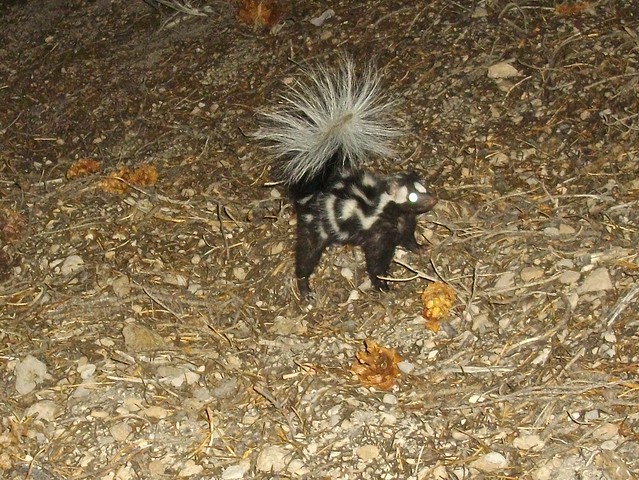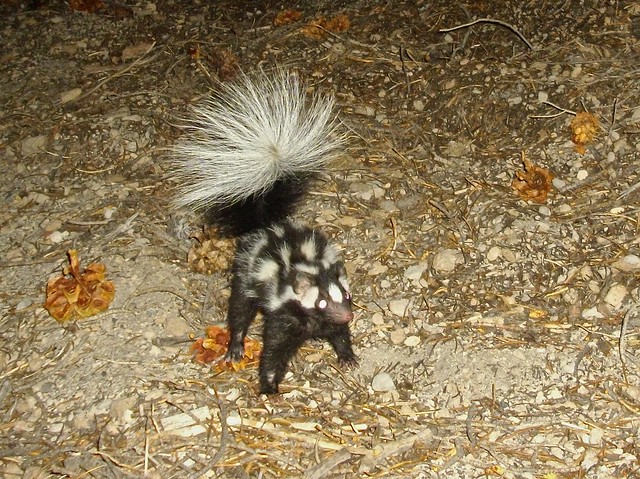The spots of my fave stinker that is - the western spotted skunk, Spilogale gracilis.
Such as these 2 photos of one I was happy to recently get on a Mono Basin hillside:


The cones near the skunk are pinyon pine. Which is interesting because it gives us a size reference. Big pinyon cones, such as the one on the far left, are about the size of a healthy lime.
With that size detail, the 2 photos pretty clearly explain an old pioneer nickname I once read for these spotty, palm-of-your-hand cutesters:
Kitten skunks.
====
References:
- Wikipedia - Western Spotted Skunk
- Nature of a Man (this blog) - Who Chews? III
- Nature of a Man (this blog) - posts on cam trapping the Mono Basin

Oh man. That guy is much smaller than I had always thought.
ReplyDeleteReally, from the first photo I thought it was a normal sized Skunk, but where there is one little one there are many and many little ones mean a big Mama is nearby.
ReplyDeleteI should have clarified that Timeless - this is an adult, not a skunklet. The spotted skunk is just much smaller than the commonly seen striped skunk. Full grown, spotted skunks are the size of kittens, and weigh just 0.5kg.
DeleteThanks for pointing out the size; I would have assumed the spotted skunks were a bit bigger. They're really cute. These skunks look like they were startled by the flash. Do you know if Rachel Kappler ever did a youtube video using your other polecat defensive poses?
ReplyDeleteIt's just one skunk - the 2 shots are the best from a handful of her (I think) coming and going. She does look a little stiff legged in these 2, but no full handstand like the other series you mention. From my experience, when the animals react, it seems to be more to the sound of the camera waking up, and not the ensuing flash. One way to tell is that I often get the same behavior night and day, and during the day, the cam doesn't flash. Once they know the cam is there and that it's not a threat, as you've seen in many of my series, they either ignore it, or get curious about it.
Deleteoh, heaven. THANK YOU! I LOVE those guys. One night I was working LATE (at Mt. Rainier), drove home at 9 p.m. in full poor-selfless-little-me and I saw a spotted skunk galloping across the road!!! All self pity vanished, and I was SO excited to a) see this creature at ALL, and b) see it alive and well! But, wow, that lime comparison is effective. Little cuties!! Great work. Thanks.
ReplyDeleteSeems like the only way to photograph these guys in the wild is by camera trap. They sure are cute.
ReplyDeleteI think there may be strong truth in that, John. I looked at all my spotty shots and every one is between 10pm and 4am, making them quite late-nighters. It may be one of the ways they coexist with striped skunks - via time slicing. They let the local stripers take the more typically used crepuscular hours.
DeleteThey're also less common though, and don't tend to live around people like striped skunks will. They're in the Santa Cruz Mtns, btw. Been documented around Hidden Villa and Rancho San Antonio.